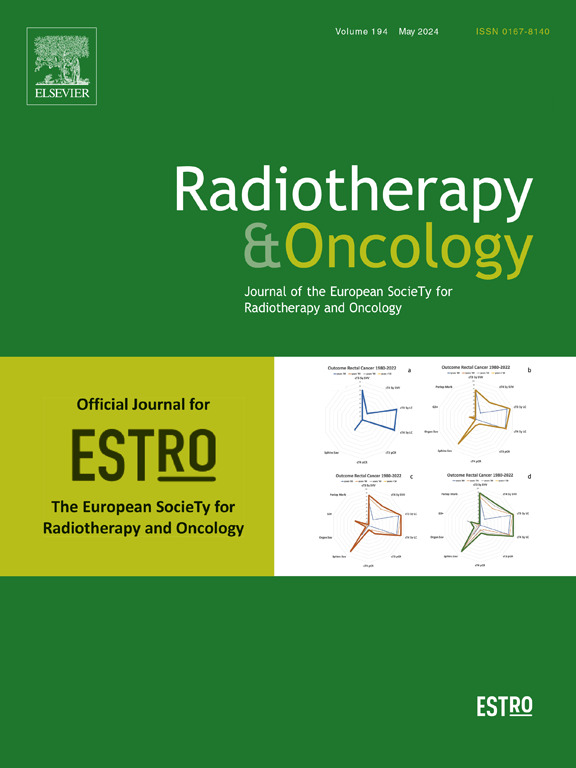Reirradiation dose constraints in clinical practice: Results of an international survey
IF 4.9
1区 医学
Q1 ONCOLOGY
引用次数: 0
Abstract
Introduction
Despite the increasing frequency of reirradiation (reRT) in cancer treatment, a critical lack of reliable dose constraint data remains. This study addresses this gap by collating current reRT constraints used in clinical practice across multiple centers, facilitating the development of more consistent and safer reRT guidelines.
Materials and methods
A comprehensive survey collected data on reRT patient numbers, dose constraints, sources, and dose summation methods for 30 OARs. Information also included PRV margins, tissue recovery factors (TRF) with time intervals, α/β values, near-Dmax definitions, and dose constraints in EQD2Gy for first and reRT courses. The relative difference (XreRT) between cumulative reRT and first course constraints was calculated. Constraints with data from at least 7 centers were included for further analysis.
Results
A median of 6 % of treatments in 17 participating centers were reRT. Most centers derived reRT constraints from the literature (81 %) or first course constraints (68 %). In total 209 cumulative near-Dmax values for 19 OARs fulfilled n ≥ 7, yielding a median inter-center variation of 21 % (IQR). While α/β values were relatively consistent, substantial variations were seen in near-Dmax volume definition, TRF, and PRV margins. The median XreRT was 26 %, primarily attributed to the TRF which had a median value of 23 %.
Conclusions
This multi-centre survey identified a concerning median inter-centre variation of 21 % in cumulative reRT dose constraints, indicating substantial heterogeneity in current clinical practices. Further prospective studies with rigorous and standardized dose reporting are essential to refine reRT guidelines, enhancing patient safety and treatment efficacy.
临床实践中的再照射剂量限制:一项国际调查结果。
导论:尽管再照射(rt)在癌症治疗中的频率越来越高,但仍然严重缺乏可靠的剂量限制数据。本研究通过整理目前在多个中心临床实践中使用的报告约束来解决这一差距,促进制定更一致和更安全的报告指南。材料和方法:一项全面的调查收集了30例OARs的rt患者人数、剂量限制、来源和剂量总和方法的数据。信息还包括PRV边缘,组织恢复因子(TRF)的时间间隔,α/β值,近dmax定义,以及EQD2Gy的首疗程和复诊疗程的剂量限制。计算累积rt与第一疗程约束的相对差值(xrt)。纳入来自至少7个中心的约束条件进行进一步分析。结果:17个参与中心的治疗中位数为6% %。大多数中心从文献(81 %)或第一疗程约束(68 %)中导出rt约束。总共有19个桨的209个累积接近dmax值满足 ≥ 7,产生21 %的中位中心间变异(IQR)。虽然α/β值相对一致,但在接近dmax的体积定义、TRF和PRV边界上可以看到实质性的变化。中位xrt为26 %,主要归因于TRF的中位值为23 %。结论:这项多中心调查确定了累积rt剂量限制的中位中心间差异为21%,表明当前临床实践中存在大量异质性。进一步的前瞻性研究,严格和标准化的剂量报告,对于完善rt指南,提高患者安全性和治疗效果至关重要。
本文章由计算机程序翻译,如有差异,请以英文原文为准。
求助全文
约1分钟内获得全文
求助全文
来源期刊

Radiotherapy and Oncology
医学-核医学
CiteScore
10.30
自引率
10.50%
发文量
2445
审稿时长
45 days
期刊介绍:
Radiotherapy and Oncology publishes papers describing original research as well as review articles. It covers areas of interest relating to radiation oncology. This includes: clinical radiotherapy, combined modality treatment, translational studies, epidemiological outcomes, imaging, dosimetry, and radiation therapy planning, experimental work in radiobiology, chemobiology, hyperthermia and tumour biology, as well as data science in radiation oncology and physics aspects relevant to oncology.Papers on more general aspects of interest to the radiation oncologist including chemotherapy, surgery and immunology are also published.
 求助内容:
求助内容: 应助结果提醒方式:
应助结果提醒方式:


